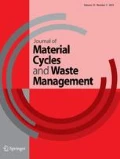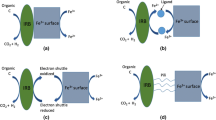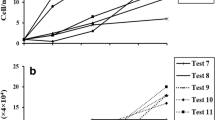Abstract
Landfill leachates contain a variety of contaminants including phosphorus, whose entry into the surface waters should be restricted given the eutrophication risks. In this study, we investigated the utility of the ferric iron bioreduction process to remove phosphorus from municipal landfill leachate. An anaerobic bioreduction experiment was conducted in diluted leachate (1:5), in the presence of Shewanella sp. (108 cell mL−1). Two iron minerals, hematite (H) and nontronite (NAU-2) were also employed as Fe(III) sources. Serial sampling was carried out during incubation at 0, 2, 5, 10, 15, 20, 25, and 30 days. The results confirmed that bioreduction of Fe(III) occurred in the presence of both iron minerals but more extensively in the presence of NAU-2. Phosphate was precipitated chemically as struvite during the first days of the experiment, correlated to the high initial concentrations of ammonium and magnesium in the leachate. Subsequently, phosphate removal was shown to be proportional to biological Fe(II) generation and creating the conditions for precipitation of vivianite. Overall, phosphate removal from leachate in suspensions containing hematite or NAU-2 was 83 and 86%, respectively.
Graphical abstract








Similar content being viewed by others
References
Renou S, Givaudan JG, Poulain S, Dirassouyan F, Moulin P (2008) Landfill leachate treatment: review and opportunity. J Hazard Mater 150(3):468–493. https://doi.org/10.1016/j.jhazmat.2007.09.077
Kim YD, Lee DG (2009) Comparative study on leachate in closed landfill sites: focusing on seasonal variations. J Mater Cycles Waste Manag 11(3):174–182. https://doi.org/10.1007/s10163-008-0246-9
Wiszniowski J, Robert D, Surmacz-Górska J, Miksch K, Weber JV (2006) Landfill leachate treatment methods: a review. Environ Chem Lett 4:51–61. https://doi.org/10.1007/s10311-005-0016-z
Hasar H, Unsal SA, Ipek U, Karatas S, Cınar O, Yaman C, Kinaci C (2009) Stripping/flocculation/membrane bioreactor/reverse osmosis treatment of municipal landfill leachate. J Hazard Mater 17:309–317. https://doi.org/10.1016/j.jhazmat.2009.06.003
Pasalari H, Farzadkia M, Gholami M, Emamjomeh MM (2018) Management of landfill leachate in Iran: valorization, characteristics, and environmental approaches. Environ Chem Lett 4:51–61. https://doi.org/10.1007/s10311-018-0804-x
Wang K, Li L, Tan F, Wu D (2018) Treatment of landfill leachate using activated sludge technology: a review. Archaea. https://doi.org/10.1155/2018/1039453
Gruber N, Galloway JN (2008) An earth-system perspective of the global nitrogen cycle. Nature 451:293–296. https://doi.org/10.1038/nature06592
Chen X, Cheng X, Chen B, Sun D, Ma W, Wang X (2015) Phosphorus precipitation in septic systems induced by iron reduction: a process for phosphorus removal under anaerobic conditions. Desalin Water Treat 54(10):2891–2901. https://doi.org/10.1080/19443994.2014.903865
Smol M (2019) The importance of sustainable phosphorus management in the circular economy (CE) model: the Polish case study. J Mater Cycles Waste Manag 21(2):227–238. https://doi.org/10.1007/s10163-018-0794-6
Carpenter SR, Caraco NF, Correll DL, Howarth RW, Sharpley AN, Smith VH (1998) Nonpoint pollution of surface waters with phosphorus and nitrogen. Ecol Appl 8(3):559–568. https://doi.org/10.1890/1051-0761(1998)008[0559:NPOSWW]2.0.CO;2
Mijangos F, Kamel M, Lesmes G, Muraviev D (2004) Synthesis of struvite by ion exchange isothermal supersaturation tecnhique. React Funct Polym 60:151–161. https://doi.org/10.1016/j.reactfunctpolym.2004.02.019
Quintana M, Colmenarejo MF, Barrera J, Sánchez E, García G, Travieso L, Borja R (2008) Removal of phosphorus through struvite precipitation using a by-product of magnesium oxide production (BMP): effect of the mode of BMP preparation. Chem Eng J 136(2–3):204–209. https://doi.org/10.1016/j.cej.2007.04.002
Wang N, Peng J, Hill G (2002) Biochemical model of glucose induced enhanced biological phosphorus removal under anaerobic condition. Water Res 36(1):49–58. https://doi.org/10.1016/S0043-1354(01)00236-6
Ozturk I, Altinbas M, Koyuncu I, Arikan O, Gomec-Yangin C (2003) Advanced physico-chemical treatment experiences on young municipal landfill leachates. Waste Manag 23(5):441–446. https://doi.org/10.1016/S0956-053X(03)00061-8
De-Bashan LE, Bashan Y (2004) Recent advances in removing phosphorus from wastewater and its future use as fertilizer (1997–2003). Water Res 38:4222–4246. https://doi.org/10.1016/j.watres.2004.07.014
Guo CH, Stabnikov V, Ivanov V (2010) The removal of nitrogen and phosphorus from reject water of municipal wastewater treatment plant using ferric and nitrate bioreductions. Bioresour Technol 101(11):3992–3999. https://doi.org/10.1016/j.biortech.2010.01.039
Azam HM, Finneran KT (2014) Fe(III) reduction-mediated phosphate removal as vivianite (Fe3(PO4)2⋅8H2O) in septic system wastewater. Chemosphere 97:1–9. https://doi.org/10.1016/j.chemosphere.2013.09.032
Ivanov V, Kuang S, Stabnikov V, Guo C (2009) The removal of phosphorus from reject water in a municipal wastewater treatment plant using iron ore. J Chem Technol Biotechnol Int Res Proc Environ Clean Technol 84(1):78–82. https://doi.org/10.1002/jctb.2009
Li X, Liu T, Li F, Zhang W, Zhou S, Li Y (2012) Reduction of structural Fe (III) in oxyhydroxides by Shewanella decolorationis S12 and characterization of the surface properties of iron minerals. J Soil Sediment 12(2):217–227. https://doi.org/10.1007/s11368-011-0433-5
Lovley DR, Phillips EJ (1998) Novel mode of microbial energy metabolism: organic carbon oxidation coupled to dissimilatory reduction of iron or manganese. Appl Environ Microbiol 54(6):1472–1480. https://doi.org/10.1128/AEM.54.6.1472-1480.1988
Lovley DR, Holmes DE, Nevin KP (2004) Dissimilatory Fe(III) and Mn(IV) reduction. Adv Microb Physiol 49:219–286. https://doi.org/10.1016/S0065-2911(04)49005-5
Weber KA, Achenbach LA, Coates JD (2006) Microorganisms pumping iron: anaerobic microbial iron oxidation and reduction. Nat Rev Microbiol 4(10):752–764. https://doi.org/10.1038/nrmicro1490
Castro L, García-Balboa C, González F, Ballester A, Blázquez ML, Muñoz JA (2013) Effectiveness of anaerobic iron bio-reduction of jarosite and the influence of humic substances. Hydrometal 131:29–33. https://doi.org/10.1016/j.hydromet.2012.10.005
Nakhaei M, Amiri V, Rezaei K, Moosaei F (2015) An investigation of the potential environmental contamination from the leachate of the Rasht waste disposal site in Iran. Bull Eng Geol Environ 74(1):233–246. https://doi.org/10.1007/s10064-014-0577-9
Karimpour-Fard M (2019) Rehabilitation of Saravan dumpsite in Rasht, Iran: geotechnical characterization of municipal solid waste. Int J Environ Sci Technol 16(8):4419–4436. https://doi.org/10.1007/s13762-018-1847-z
Shariatmadari N, Lasaki BA, Eshghinezhad H, Alidoust P (2018) Effects of landfill leachate on mechanical behaviour of adjacent soil: a case study of Saravan landfill, Rasht, Iran. Int J Civil Eng 16(10):1503–1513. https://doi.org/10.1007/s40999-018-0311-2
Bakhshipour A, Bagheri I, Psomopoulos C, Zareiforoush H (2020) An overview to current status of waste generation, management and potentials for waste-to-energy (Case study: Rasht City, Iran). Casp J Environ Sci 19(2):131–143
Baird RB (2017) Standard methods for the examination of water and wastewater, 23rd. Water Environment Federation, American Public Health Association, American Water Works Association
Copeland A, Lytle DA (2014) Measuring the oxidation–reduction potential of important oxidants in drinking water. J Am Water Work Ass 106(1):10–20. https://doi.org/10.5942/jawwa.2014.106.0002
Huang JH, Voegelin A, Pombo SA, Lazzaro A, Zeyer J, Kretzschmar R (2011) Influence of arsenate adsorption to ferrihydrite, goethite, and boehmite on the kinetics of arsenate reduction by Shewanella putrefaciens strain CN-32. Environ Sci Technol 45:7701–7709. https://doi.org/10.1021/es201503g
Ghorbanzadeh N, Lakzian A, Halajnia A, Kabra AN, Kurade MB, Lee DS, Jeon BH (2015) Influence of clay minerals on sorption and bioreduction of arsenic under anoxic conditions. Environ Geochem Health 37(6):997–1005. https://doi.org/10.1007/s10653-015-9708-x
Keeling JL, Raven MD, Gates WP (2000) Geology and characterization of two hydrothermal nontronites from weathered metamorphic rocks at the Uley graphite mine, South Australia. Clay Clay Miner 48:537–548. https://doi.org/10.1346/CCMN.2000.0480506
Stookey LL (1970) Ferrozine—a new spectrophotometric reagent for iron. Anal Chem 42:779–781. https://doi.org/10.1021/ac60289a016
Dong H, Kukkadapu R, Fredricjson J, Zachara J, Davidw K, Kostandarithes H (2003) Microbial reduction of structural Fe(III) in illite and goethite. Environ Sci Technol 37:1268–1276. https://doi.org/10.1021/es020919d
Ministry of Energy (2010) Environmental regulation for reuse and recycling of waste water, Bulletin No. 535, Deputy Director of Strategic Control, Ministry of Energy, Iran
Foo KY, Hameed BH (2009) An overview of landfill leachate treatment via activated carbon adsorption process. J Hazard Mater 171(1–3):54–60. https://doi.org/10.1016/j.jhazmat.2009.06.038
Madigan MT, Bender KS, Buckley DH, Sattley WM, Stahl DA (2018) Brock biology of microorganisms, 15th, Global. Benjamin Cummins, Boston
Urrutia MM, Roden EE, Fredrickson JK, Zachara JM (1998) Microbial and surface chemistry controls on reduction of synthetic Fe (III) oxide minerals by the dissimilatory iron-reducing bacterium Shewanella alga. Geomicrobiol J 15(4):269–291. https://doi.org/10.1080/01490459809378083
Liu C, Zachara JM, Gorby YA, Szecsody JE, Brown CF (2001) Microbial reduction of Fe (III) and sorption/precipitation of Fe (II) on Shewanella putrefaciens strain CN32. Environ Sci Technol 35(7):1385–1393. https://doi.org/10.1021/es0015139
Cooper DC, Picardal FW, Schimmelmann A, Coby AJ (2003) Chemical and biological interactions during nitrate and goethite reduction by Shewanella putrefaciens 200. Appl Environ Microbiol 69(6):3517–3525. https://doi.org/10.1128/AEM.69.6.3517-3525.2003
Roden EE, Urrutia MM, Mann CJ (2000) Bacterial reductive dissolution of crystalline Fe (III) oxide in continuous-flow column reactors. Appl Environ Microbiol 66(3):1062–1065. https://doi.org/10.1128/AEM.66.3.1062-1065.2000
Schwalb C, Chapman SK, Reid GA (2003) The tetraheme cytochrome CymA is required for anaerobic respiration with dimethyl sulfoxide and nitrite in Shewanella oneidensis. Biochem 42:9491–9497. https://doi.org/10.1021/bi034456f
Zhang J, Dong H, Liu D, Fischer TB, Wang S, Huang L (2012) Microbial reduction of Fe (III) in illite–smectite minerals by methanogen Methanosarcina mazei. Chem Geol 292:35–44. https://doi.org/10.1016/j.chemgeo.2011.11.003
Bishop ME, Dong H, Kukkadapu RK, Liu C, Edelmann RE (2011) Bioreduction of Fe-bearing clay minerals and their reactivity toward pertechnetate (Tc-99). Geochim Cosmochim Ac 75(18):5229–5246. https://doi.org/10.1016/j.gca.2011.06.034
Dong H, Jaisi DP, Kim J, Zhang G (2009) Microbe–clay mineral interactions. Am Mineral 94:1505–1519. https://doi.org/10.2138/am.2009.3246
Li Q, Wang X, Kan D, Bartlett R, Pinay G, Ding Y, Ma W (2012) Enrichment of phosphate on ferrous iron phases during bio-reduction of ferrihydrite. Int J Geosci 3(02):314–320. https://doi.org/10.4236/ijg.2012.32033
Sørensen J (1982) Reduction of ferric iron in anaerobic, marine sediment and interaction with reduction of nitrate and sulfate. Appl Environ Microbiol 43(2):319–324. https://doi.org/10.1128/AEM.43.2.319-324.1982
Weber KA, Urrutia MM, Churchill PF, Kukkadapu RK, Roden EE (2006) Anaerobic redox cycling of iron by freshwater sediment microorganisms. Environ Microbiol 8(1):100–113. https://doi.org/10.1111/j.1462-2920.2005.00873.x
Dichristina TJ (1992) Effects of nitrate and nitrite on dissimilatory iron reduction by Shewanella putrefaciens 200. J Bacteriol 174(6):1891–1896. https://doi.org/10.1128/jb.174.6.1891-1896.1992
Yoon S, Sanford RA, Löffler FE (2015) Nitrite control over dissimilatory nitrate/nitrite reduction pathways in Shewanella loihica strain PV-4. App Environ Microbiol 81(10):3510–3517. https://doi.org/10.1128/AEM.00688-15
Cruz-Garcia C, Murray AE, Klappenbach JA, Stewart V, Tiedje JM (2007) Respiratory nitrate ammonification by Shewanella oneidensis MR-1. J Bacteriol 189:656–662. https://doi.org/10.1128/JB.01194-06
Haaijer SC, Harhangi HR, Meijerink BB, Strous M, Pol A, Smolders AJ, Verwegen K, Jetten MS, Op den Camp HJ (2008) Bacteria associated with iron seeps in a sulfur-rich, neutral pH, freshwater ecosystem. ISME J 2:1231–1242. https://doi.org/10.1038/ismej.2008.75
Ottow JCG (1970) Selection, characterization and iron-reducing capacity of nitrate reductaseless (nit-) mutants of iron-reducing bacteria. Z Allg Mikrobiol 10:55–62. https://doi.org/10.1002/jobm.19700100105
Cheng X, Chen B, Cui Y, Sun D, Wang X (2015) Iron (III) reduction-induced phosphate precipitation during anaerobic digestion of waste activated sludge. Sep Purif Technol 143:6–11. https://doi.org/10.1016/j.seppur.2015.01.002
Green J, Paget MS (2004) Bacterial redox sensors. Nat Rev Microbiol 2:954–966. https://doi.org/10.1038/nrmicro1022
Huang H, Xiao D, Zhang Q, Ding L (2014) Removal of ammonia from landfill leachate by struvite precipitation with the use of low-cost phosphate and magnesium sources. J Environ manag 145:191–198. https://doi.org/10.1016/j.jenvman.2014.06.021
Tonetti AL, de Camargo CC, Guimarães JR (2016) Ammonia removal from landfill leachate by struvite formation: an alarming concentration of phosphorus in the treated effluent. Water Sci Technol 74(12):2970–2977. https://doi.org/10.2166/wst.2016.490
Babic-Ivancici V, Kontrec J, Kralj D, Brecvic L (2002) Precipitation diagrams of struvite and dissolution kinetics of different struvite morphologies. Croat Chem Acta 75(1):89–106
Liu J, Cheng X, Qi X, Li N, Tian J, Qiu B, Xu K, Qu D (2018) Recovery of phosphate from aqueous solutions via vivianite crystallization: Thermodynamics and influence of pH. Chem Eng J 349:37–46. https://doi.org/10.1016/j.cej.2018.05.064
Acknowledgements
Appreciation is expressed to the Caspian Sea Basin Research Center for the support of the research.
Author information
Authors and Affiliations
Contributions
Conceptualization: NG and MBF, methodology: ZG, formal analysis and investigation: MK, writing—original draft preparation: MBF and NG; review and editing: AU, funding acquisition, resources, and supervision: MBF.
Corresponding author
Ethics declarations
Conflict of interests
The authors declare that they have no potential conflict of interest. In addition, ethical issues, including plagiarism, informed consent, misconduct, data fabrication and/or falsification, double publication and/or submission, and redundancy were completely observed by the authors.
Additional information
Publisher's Note
Springer Nature remains neutral with regard to jurisdictional claims in published maps and institutional affiliations.
Rights and permissions
About this article
Cite this article
Farhangi, M.B., Ghasemzadeh, Z., Ghorbanzadeh, N. et al. Phosphate removal from landfill leachate using ferric iron bioremediation under anaerobic condition. J Mater Cycles Waste Manag 23, 1576–1587 (2021). https://doi.org/10.1007/s10163-021-01239-y
Received:
Accepted:
Published:
Issue Date:
DOI: https://doi.org/10.1007/s10163-021-01239-y




